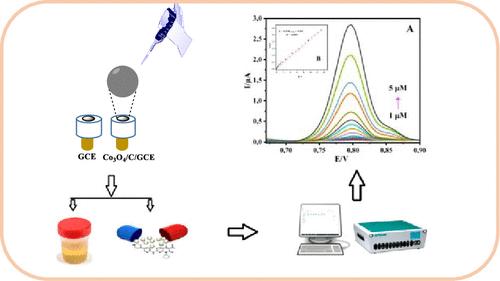将 Co3O4/C 异质结构应用于快速分析药物制剂和生物液体中的抗癌药物帕博西尼(Palbociclib)的卓越电化学传感器
IF 3.9
2区 化学
Q2 CHEMISTRY, MULTIDISCIPLINARY
引用次数: 0
摘要
在这项工作中,我们报告了一项研究,该研究探讨了不同盐浓度如何影响两种 Co3O4/C 材料的结构和电化学性能,这两种材料设计用于制造一种简便、廉价、快速、安全且有用的电化学传感器,以检测 Palbociclib (PLB)。通过使用熔盐辅助方法将 Co3O4 纳米粒子封装在掺杂 N 的无定形碳基质中,成功地制造出了 Co3O4 纳米粒子。在此过程中,使用了不同量的碘酸钾和沸石咪唑酸盐框架-12(ZIF-12),然后在 800 °C 下进行热解。获得了最佳的 Co3O4 嵌入多孔碳结构,并将电化学性能最高的复合材料修饰到玻璃碳电极(GCE)表面,用于检测 PLB。该方法的线性范围为1.0~5.0 μM,检出限为0.122 μM,定量限为0.408 μM,相关系数为0.995。该方法的回收率为99.3%~101.3%,相对标准偏差(RSD)为3%。因此,这项技术将为监测和改进现有的癌症治疗方案做出重大贡献。本文章由计算机程序翻译,如有差异,请以英文原文为准。

Superior Electrochemical Sensor Application of Co3O4/C Heterostructure in Rapid Analysis of Anticancer Drug Palbociclib in Pharmaceutical Formulations and Biological Fluids
In this work, we report a study examining how different salt concentrations affect the structure and electrochemical performance of two Co3O4/C materials designed for the fabrication of an easy, cheap, fast, safe, and useful electrochemical sensor for the detection of Palbociclib (PLB). Co3O4 nanoparticles were successfully created by encapsulating them in N-doped amorphous carbon matrices by using the molten salt-assisted approach. In this process, different amounts of potassium iodate and zeolitic imidazolate framework-12 (ZIF-12) were used, followed by pyrolysis at 800 °C. Optimum Co3O4 embedded porous carbon structures were obtained, and the composite with the highest electrochemical properties was modified to a glassy carbon electrode (GCE) surface for PLB detection. The linear response spanned from 1.0 to 5.0 μM, featuring a limit of detection (LOD) of 0.122 μM and a limit of quantification (LOQ) of 0.408 μM; the correlation coefficient was calculated as 0.995. The high sensitivity of the method in detecting PLB in pharmaceutical samples and human urine demonstrated its feasibility, with recovery percentages ranging from 99.3% to 101.3% and relative standard deviation (RSD) values of <3%. Therefore, this technique will make a significant contribution to monitoring and improving existing cancer treatment options.
求助全文
通过发布文献求助,成功后即可免费获取论文全文。
去求助
来源期刊

Langmuir
化学-材料科学:综合
CiteScore
6.50
自引率
10.30%
发文量
1464
审稿时长
2.1 months
期刊介绍:
Langmuir is an interdisciplinary journal publishing articles in the following subject categories:
Colloids: surfactants and self-assembly, dispersions, emulsions, foams
Interfaces: adsorption, reactions, films, forces
Biological Interfaces: biocolloids, biomolecular and biomimetic materials
Materials: nano- and mesostructured materials, polymers, gels, liquid crystals
Electrochemistry: interfacial charge transfer, charge transport, electrocatalysis, electrokinetic phenomena, bioelectrochemistry
Devices and Applications: sensors, fluidics, patterning, catalysis, photonic crystals
However, when high-impact, original work is submitted that does not fit within the above categories, decisions to accept or decline such papers will be based on one criteria: What Would Irving Do?
Langmuir ranks #2 in citations out of 136 journals in the category of Physical Chemistry with 113,157 total citations. The journal received an Impact Factor of 4.384*.
This journal is also indexed in the categories of Materials Science (ranked #1) and Multidisciplinary Chemistry (ranked #5).
 求助内容:
求助内容: 应助结果提醒方式:
应助结果提醒方式:


